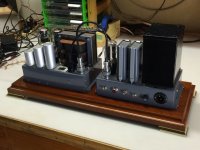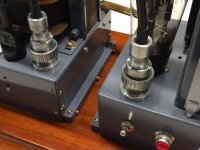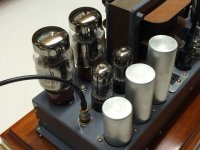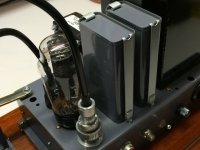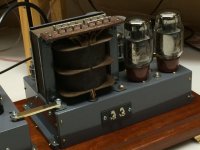Restoration complete!
This final set of posts has been a long time coming, but we've now finally completed the Williamson restoration and mounted the two chassis on a base.
The amplifier has been running well for nearly a year, mostly using the original Bakers Selhurst driver in the huge bass reflex enclosure my dad made for it. The combination still sounds pretty impressive!
The other reason for taking nearly 12 months to get the restoration finished is that we got seriously distracted sourcing, then restoring an original mono Acoustical (QUAD) pre-amplifier. This has been a challenging project, but we now have volume and tone controls and when we've figured out the equalisation filters we'll have a workable phono pre-amp stage.
The base for the amplifier chassis is made from a slab of timber (some sort of eucalyptus) from a junk shop, with routed detail and a traditional french polish finish. I'll make an acrylic cover at some stage to keep the dust off when not in use.
Thanks again to all who contributed on this thread. We couldn't have got it running again without your help.
This final set of posts has been a long time coming, but we've now finally completed the Williamson restoration and mounted the two chassis on a base.
The amplifier has been running well for nearly a year, mostly using the original Bakers Selhurst driver in the huge bass reflex enclosure my dad made for it. The combination still sounds pretty impressive!
The other reason for taking nearly 12 months to get the restoration finished is that we got seriously distracted sourcing, then restoring an original mono Acoustical (QUAD) pre-amplifier. This has been a challenging project, but we now have volume and tone controls and when we've figured out the equalisation filters we'll have a workable phono pre-amp stage.
The base for the amplifier chassis is made from a slab of timber (some sort of eucalyptus) from a junk shop, with routed detail and a traditional french polish finish. I'll make an acrylic cover at some stage to keep the dust off when not in use.
Thanks again to all who contributed on this thread. We couldn't have got it running again without your help.
Attachments
Some detail shots. All those capacitors on top are dummies, the original items, but not used in circuit. The KT66s are new, but the rectifier is the 60 year old original.
Graham.
Graham.
Attachments
Hello
just found this thread ... what a lovely little retro project, well done. I was thinking of making one of these from scratch as I have most of the parts and a full modern transformer set ... thanks for posting
well done ....
just found this thread ... what a lovely little retro project, well done. I was thinking of making one of these from scratch as I have most of the parts and a full modern transformer set ... thanks for posting
well done ....
Oldvinyl-,
Also coming late on this, scanned through it, congratulations on a job well done!
Now how to put this .......
It concerns the Quad pre-amp. Point: There has been serious capacitor degradation with the years in some styrene caps in the Quad 22 stereo preamp. I cannot recall the mono pre-amp although I have worked on one many moons ago , so not to alarm you.
On the Quad 22 this degradation causes quite poor sound. I can only refer to the relevant caps as numbered on the Q-22 schematic (as far as I recall the circuits were identical). On the Q-22 they were numbered C18 - C31. All had to do with the tone controls and filters. If you can look these up on a Q-22 schematic, you should be able to easily trace the equivalents on the mono pre-amp.
The point is that those caps crossly changed in µF values; why, nobody could tell (they were good British brands). But I found this in several Q-22 pre-amps passing my way. So - not to panic, but you may be wise to just check the similar ones in your pre-amp before being disillusioned by a possible poor sound. Hope you can find a capacitor meter somewhere.
I hope for your sake that the malady does not occur in your pre-amp; simply thought it wise to warn in advance, in case.
Also coming late on this, scanned through it, congratulations on a job well done!
Now how to put this .......
It concerns the Quad pre-amp. Point: There has been serious capacitor degradation with the years in some styrene caps in the Quad 22 stereo preamp. I cannot recall the mono pre-amp although I have worked on one many moons ago , so not to alarm you.
On the Quad 22 this degradation causes quite poor sound. I can only refer to the relevant caps as numbered on the Q-22 schematic (as far as I recall the circuits were identical). On the Q-22 they were numbered C18 - C31. All had to do with the tone controls and filters. If you can look these up on a Q-22 schematic, you should be able to easily trace the equivalents on the mono pre-amp.
The point is that those caps crossly changed in µF values; why, nobody could tell (they were good British brands). But I found this in several Q-22 pre-amps passing my way. So - not to panic, but you may be wise to just check the similar ones in your pre-amp before being disillusioned by a possible poor sound. Hope you can find a capacitor meter somewhere.
I hope for your sake that the malady does not occur in your pre-amp; simply thought it wise to warn in advance, in case.
Thanks jamesfeline, jazbo8, and Johan for your kind words. This was indeed a fun project, particularly because my dad and I did it together. Getting it running again after all those years has given my dad great pleasure.
Johan, The Acoustical pre-amp that we got (from ebay) is the early mono version, QCII (not even labeled QUAD). We replaced a missing valve and it worked straight away but had very bad audible distortion. Probing around with a volt meter indicated anode voltages way out of spec so I replaced the coupling capacitors and other obviously dodgy looking capacitors. It then ran and sounded acceptable. We now need to make one of the plug-in equalisation modules to suit a modern cartridge, then we can play some vinyl through the system.
I'll start another thread when I get time to get back on the QCII project. I'll be needing some assistance to calculate the correct values for the equalisation module. I also want to do a frequency response and distortion measurement to check that the main pre-amp section is working correctly.
Graham.
Johan, The Acoustical pre-amp that we got (from ebay) is the early mono version, QCII (not even labeled QUAD). We replaced a missing valve and it worked straight away but had very bad audible distortion. Probing around with a volt meter indicated anode voltages way out of spec so I replaced the coupling capacitors and other obviously dodgy looking capacitors. It then ran and sounded acceptable. We now need to make one of the plug-in equalisation modules to suit a modern cartridge, then we can play some vinyl through the system.
I'll start another thread when I get time to get back on the QCII project. I'll be needing some assistance to calculate the correct values for the equalisation module. I also want to do a frequency response and distortion measurement to check that the main pre-amp section is working correctly.
Graham.
- Status
- Not open for further replies.
